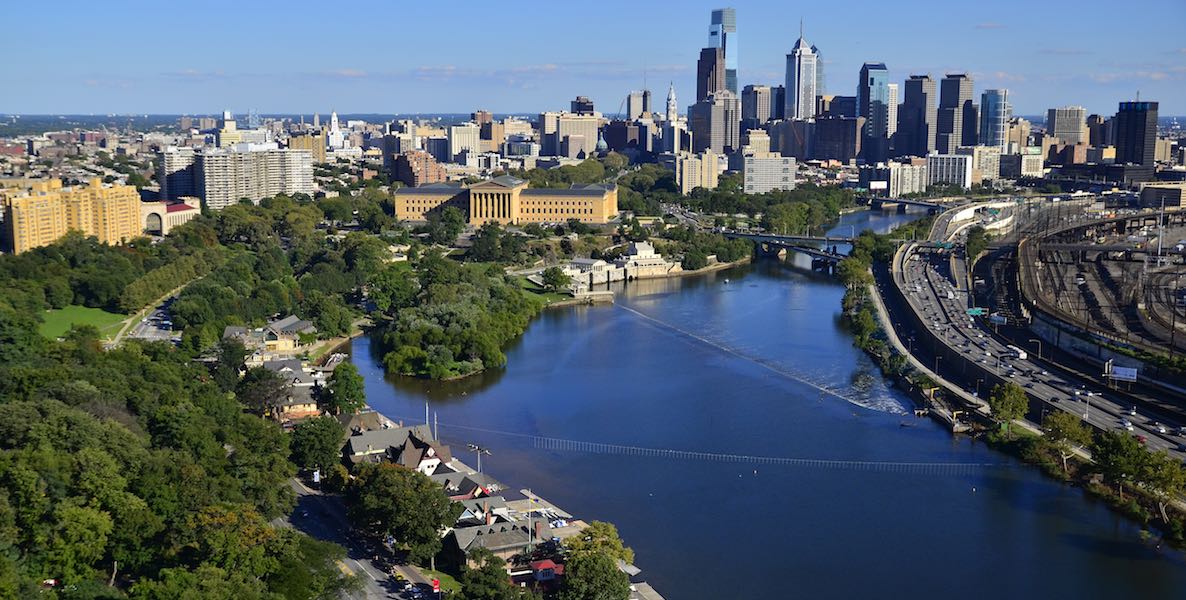Answering TrumpRead More
So how can Urban World brace itself for its accelerating crash into Trump World? I’ve got three modest proposals. Two weeks ago, I posited that we need to remake our City Charter into a moral document. Last week, the idea was to launch an ambitious internship program, requiring all college students to serve and improve city government.
Institutions do not change easily. But the city as an institution is also a reflection of our ideals, and the way to affect change is to realign our ideals with our new reality. We need to reconstruct American federalism so that cities take their rightful place alongside states as sovereign powers.
Which gets us to this week’s big idea:
Let’s Get Bigger
Unlike the sparsely settled flyover states whose political power rests on their disproportionate representation in the U.S. Senate and the Electoral College, the power of cities rests in the size of their populations. And cities increase in population primarily by increasing in land size, as was true of Mid-Atlantic and Midwestern cities during their major growth spurts in the mid- and late-19th Century. In 1854, Philadelphia city expanded from approximately 2 to 130 square miles by consolidating with the larger county; between 1851 and 1920, Chicago gradually expanded by annexing surrounding townships in Cook County and then grew substantially in 1889 with the annexation of four townships; in 1874 New York City expanded beyond Manhattan Island by annexing three towns to its North in Westchester County, and in 1898 the city expanded massively by annexing Staten Island, the western end of Long Island (Queens and Brooklyn), and more of Westchester County (which later became the Bronx).

Connect With Our Social Action Team
We believe that everyone should be engaged in their community. But sometimes it's hard to know where to start.
That's why our Social Action Team is here. Contact us and we'll help find the best opportunity for you to get involved and make a difference.
CLICK HERE TO EMAIL US
After World War II, with only a few exceptions, the big Mid-Atlantic and Midwestern cities stopped expanding geographically and started losing population. At the same time, southwestern cities expanded rapidly in terms of both land size and population: Between 1950 and 1990, for instance, Houston went from 596,163 people spread over 160 square miles to 1,630,553 people spread over 539 square miles; Dallas from 434,462 people over 112 square miles to 1,006,877 people over 342 square miles; and Phoenix from 106,818 people over 17 square miles to 983,403 people over 420 square miles.
There are several different reasons why Mid-Atlantic and Midwestern cities stopped expanding geographically after World War II, but possibly the most important were race and schools. Unlike the Southwest, cities such as Philadelphia, Chicago, and New York were on the path of the massive northward migration of African Americans. It is hardly an oversimplification to say that, as black people arrived in Northern cities, white people moved to the suburbs.
In the decades after World War II, Philadelphia became more Democratic and the suburban counties became more Republican—so much so that in 1979 Ronald Reagan lauded Montgomery as one of the strongest Republican counties in the entire country. Yet recently, in important respects, the suburbs have come to look more like the city. The share of registered Republicans has declined, to the point where there are today more registered Democrats than Republicans in Montgomery, Delaware, and Bucks counties. Each voted by majorities for Hillary Clinton over Donald Trump—as did Chester County, where registered Republicans outnumber registered Democrats.
A key feature of all the suburbs surrounding Philadelphia is that they are fragmented into multiple municipalities, each with their own bundle of services, such as different school districts and land use policies. Similarly, the city offers taxpayers a set of unique services. The advent and proliferation of charter schools in Philadelphia provides a more varied bundle of school choices to city parents, similar to the suburbs. Furthermore, business improvement districts—of which there are 13 currently operating in Philadelphia—are special zones typically covering commercial corridors that charge additional taxes for additional services, most notably security and street cleaning. As geographically smaller tax districts that use those taxes only for their districts and do not have to distribute them throughout the larger (mostly poorer) city, BIDs look a bit like suburban municipalities.
A more extreme but, oddly enough, possibly more politically viable form of consolidation would be for Bucks, Montgomery, Chester, Delaware, and Philadelphia counties to separate from Pennsylvania and form a new state. This city-state, as it were, would cover nearly 2,200 square miles, which would make it slightly larger than Delaware; it would include approximately 4 million people, putting it in the middle of the pack in terms of population size, between Kentucky and Oregon.
The fragmentation of city services through organizational tools such as BIDs and charter schools arguably exacerbates Philadelphia’s stark economic divides. The point here is not to promote them, but to note that they make Philadelphia look a bit more like the surrounding suburbs. So why don’t we push this notion of city and suburb convergence to its logical conclusion and revive the municipal consolidation movement that stalled out a century ago?
Looking at nine relatively recent cases of city-county consolidations, professors Suzanne Leland and Kurt Thurmaier found that there was some evidence that city-county consolidations led to greater economic development. What they do not consider, but which is central to the notion of strengthening Urban World against Trump World, is whether consolidation might create a politically stronger city, at the very least in the sense of having a larger state legislative and Congressional delegation with a relatively unified agenda.
In the case of Philadelphia and its surrounding suburbs, we can trace out at least three potential scenarios for this convergence, from mild integration to extreme consolidation. Critics might easily claim that they are all unrealistic and would raise many practical problems. I’m happy to concede that point, but I would also suggest, as I do at the end of this essay, that even the attempt to enact any form of city-suburban integration would itself have positive benefits.
A mild integration, modeled after the Portland Metro area, would be to empower an existing regional agency such as SEPTA so that it looked more like a general-purpose government by, for instance, providing it new sources of tax revenue, expanding its scope of responsibilities beyond mass transit, and making its board of directors elective. In addition to potentially creating greater efficiencies and more accountability in regional planning and public investment, an elected metro-level governing body would provide a platform for a more unified political discussion between Philadelphia and the suburban counties, without threatening the autonomy of the suburbs.
More extreme would be a traditional city-county consolidation, where Philadelphia and its surrounding counties join to form a single city government, though possibly with some sort of quasi-federal arrangement where the counties maintain some autonomy. Realistically, the only surrounding suburbs that would have any incentive to consolidate with Philadelphia would be in Delaware and Montgomery counties, since they are the most Democratic and have local tax burdens equal to or even greater than those in Philadelphia. In some instances, they are fiscally distressed enough that becoming part of the city might be financially attractive.
Under Pennsylvania law it is not particularly hard for two or more municipalities that feel so inclined to merge into one. The separate municipal governments can agree to a merger, which then has to be approved by voters in a referendum. Alternately, merger votes can be initiated by petitions signed by registered voters in each municipality, equal in number to five percent of the total votes cast for governor in the last general election.
An even more extreme but, oddly enough, possibly more politically viable form of consolidation would be for Bucks, Montgomery, Chester, Delaware, and Philadelphia counties to separate from Pennsylvania and form a new state. This city-state, as it were, would cover nearly 2,200 square miles, which would make it slightly larger than Delaware; it would include approximately 4 million people, putting it in the middle of the pack in terms of population size, between Kentucky and Oregon.
The very effort of trying to enact any of these forms of integration would have positive benefits. Just the act of petitioning would create new city-suburban political coalitions which would themselves be a form of integration that might move us toward a more genuinely metropolitan politics, and then to more formal integration.
Politically speaking, the city-state of Philadelphia would take five Congressional districts and electoral votes away from Pennsylvania, while adding two additional voters to the Electoral College. Splitting Pennsylvania into two states might have a minor impact on the party composition of its eighteen-member Congressional delegation, though it would depend on how either state redrew its districts after the split. A more predictable outcome would be to transform what is currently a swing state in presidential elections into fifteen guaranteed electoral votes for Republicans and seven guaranteed electoral votes for Democrats, which in no presidential election since at least 2000 would have changed the outcome. In the longer term the Democrats would probably pick up more electoral votes if Pennsylvania were to split in two, as Philadelphia and its surrounding counties have on average experienced more rapid population growth than the rest of the state.
Creating the city-state of Philadelphia might be more politically viable than a traditional city-county consolidation. Being part of a five-county city-state would probably help both the city and the suburbs economically. Rough estimates suggest that Pennsylvania provides more money in services to Philadelphia than the city’s residents pay in state taxes, yet the bulk of that additional money comes from the taxes collected in the four outlying counties, which are the wealthiest in the state. As counties in the city-state of Philadelphia, Montgomery, Bucks, Delaware, and Chester would still be supporting the city, but they would no longer be supporting rural counties, most of which are just as poor, or poorer, than Philadelphia.
Congress and the Pennsylvania General Assembly would have to approve the splitting of Pennsylvania, and there is some reason to believe that both might be more amenable to the plan than the General Assembly would be to expanding Philadelphia, which would most likely only empower Democrats at the state level. At the Congressional level, the idea of letting Southeastern Pennsylvania (SEPA) split off and form its own state might make for interesting coalitions—such as with the conservative northern end of California, which has for some time wanted to split off to form the independent State of Jefferson. At the state legislative level, some recent polls have suggested a good deal of support for letting SEPA leave the state. And as Paul Beers noted of the conflict between Philadelphia and the rest of the state in the legislature in his classic book, Pennsylvania Politics Today and Yesterday (1980), “Many maintain that Philadelphia, or the Delaware Valley, ought to be a state unto itself. Short of that, the politicians try to cope with the conflict.” It seems that now more than ever we could make that dream a reality.
The very effort of trying to enact any of these forms of integration would have positive benefits. Consider, for instance, a scenario where activists in each of the five counties start collecting signatures on petitions, asking their respective boards of elections to have the question of forming a new state included as a question on the ballot in the next general election (such ballot questions are most likely not allowed under state law, but the petitioning itself is legal and if successful would certainly put political pressure on the counties and the state). Just the act of petitioning would create new city-suburban political coalitions which would themselves be a form of integration that might move us toward a more genuinely metropolitan politics, and then to more formal integration.
Of course, these are huge undertakings that would typically only be considered during moments of crisis or significant institutional flux. We may be in one of those times.
Header photo by B. Krist for Visit Philadelphia





